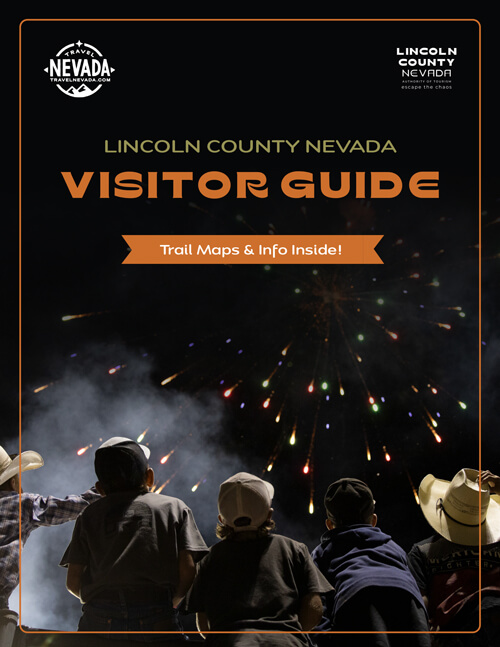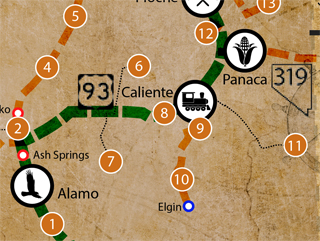Menu

Mining Loop
Driving along SR 321, watch carefully for scrub and pinyon jays. In the town itself, you will see the “usual” selection of town birds, and you may hear the jays cawing raucously as they fly over the town. Go north through the town back to US 93 and one mile north, take SR 320 (Caselton Road). Along this road, you have opportunities to head west on a couple of graveled roads – the Stampede Gap Road, and the Highland Peak Road. If you have high clearance, you can drive back in a ways, and then listen for chickadees, nuthatches, and other forest birds. Returning south on SR 320 to Highway 93, keep a watch out for Greater Roadrunners, and Wild Horses.
State Park Route
From Pioche, head east on SR 322, following the paved road all the way to Spring Valley State Park. There is a park entrance fee to continue into the park, and it is well worth it to spend an hour or so in the park. (The day pass is good at the other State Parks in the area on the same day of purchase.) Eagle Valley Reservoir is a man-made lake, and you will see the more “tame” ducks and waterfowl around the fishing dock and boat-launch area (Coots, Mallards). You may also see (or hear) Black-crowned Night Herons, various grebes, teals, Ruddy ducks, Redheads & Canvasbacks, yellow-headed and red-winged blackbirds – and in the upper part of the lake where the stream comes in, you may see Great Blue Herons and various Egrets, Canada geese, and Belted kingfishers. Driving further north on the gravel road to the Stone Cabin Living History Museum, park and take the trail behind the cabin, up to the spring, ½ mile. The trail will wind through boulders and cliffs of the igneous rock formation, tuff. On these tuff cliffs, look up and notice the Cliff Swallow nests; in the summer, you may be dive-bombed by these birds as they hunt for insects. Continuing north on the gravel road past the Ranger Station, you will come to a turn east on the road, and pass by a rock flood-control dam. Just before this dam, there is a gate in the fence (not where the private property is), and a little two-track wagon road continues north. Walk up this road, and in the right season, you may be treated to the sounds of the Sage Grouse as they strut and “drum” in their unusual courtship routine.
Return south to the community of Ursine; turn left at a road just before Eagle Valley Resort, and follow this paved County road along the south side of Eagle Valley. It will make a number of twists and turns around fields and hay-stacks, and watch for Western Meadowlarks, Mountain and Western Bluebirds, Lark Sparrows, and occasionally Roadrunners. The road will go through another canyon of Tuff rocks, and more Cliff Swallows and Belted Kingfishers may be seen if you stop to watch. Listen for the gurgling and burbling song of the Yellow-Breasted Chat, or the Willow Flycatcher in the Willow and cottonwood trees along Meadow Valley Wash, which you will cross partway through the canyon. Look up also – hawks and eagles (Golden, sometimes Bald) are often soaring over these canyon walls.
When you come into the settlement of Rose Valley, take a left at the Bridge and follow this road to Echo Canyon State Park (the road turns to gravel in Rose Valley, so taking a left at the bridge continues on the paved County road). Again, watch for the same birds along the fields. When you enter Echo Canyon State Park, the road will dip and cross Meadow Valley Wash again. Just before this dip, there is a small parking area and a trail with a bridge to cross the creek and sit at a bench, enjoying the sounds of Chats, Flycatchers, Black Phoebes and other songbirds. The road will twist and turn through basalt and tuff cliffs, and keep a sharp eye out for Great Blue Herons in the shallow portions of the creek below. A pedestrian bridge crosses the creek just beyond a picnic table pull-out, and this offers a good view of the lake just west. Rock wrens and Canyon wrens may chatter at you, and the Cliff swallows may be joined by violet-green swallows and white-throated swifts. In the spring, when Meadow Valley Wash is running high from snow-melt, a larger variety of waterfowl may be seen at Echo Canyon, including cormorants, grebes, American White Pelicans, loons, and shorebirds such as American Avocets, Stilts, killdeer and sandpipers. Driving through the campground, in the summer, Western tanagers, orioles, and hummingbirds often visit the flowers, and feeders that campers put up for them. Vireos may be plying the sagebrush and rabbitbrush thickets, and in the fall, Cedar Waxwings visit the Russian Olive trees to feast on the tiny olives. Serious bird-watchers may spend an entire day on this loop, or continue back to US 93 to head south to Cathedral Gorge State Park, where a variety of songbirds may be seen at the carefully landscaped Regional Visitor Center. In the park itself, the Rock Wrens, Say’s Phoebes, Western Kingbirds, Mockingbirds and Barn swallows keep the insect population under control by day, while bats rule the skies at night. Black-throated and Sage Sparrows in summer, white-crowned sparrows in winter take turns feeding on the seeds from desert shrubs and grasses. Occasionally Lark sparrows and Lincoln sparrows join them in these forays. At night, Great horned owls and Barn owls take flight from their roosts in the narrow slot canyons, called “caves” by local residents, and some campers get to see or hear the Common and Lesser Nighthawks as they swoop through the air at dusk.
Not mentioned on the tour, but important to birders, is the town of Panaca. Lush, watered meadows border the town on the west, and a variety of birds may be seen in the meadows or around town. In the summer months, Snipe may be heard “winnowing” through the night air over the meadows, and a careful eye may spot them on fenceposts during the day. Ring-neck Pheasants have been raised by a local resident, and these may be spotted around town (until a wandering coyote picks them off for dinner). Summer tanagers, Indigo or Painted buntings, Vermillion Flycatchers can sometimes be seen in trees around town; Bullock’s orioles, hummingbirds, Lesser and a few American Goldfinches are attracted to feeders, along with the lesser-desired Great-tailed Grackles, Brown-headed cowbirds, starlings, Brewer’s and Red-winged Blackbirds. In the spring when Meadow Valley Wash is running high, the meadows will be wet, and waterfowl and shorebirds stop by, often spending a day or two before heading further north on their migration. In the fall, after fields of corn have been cut, Sandhill Cranes may be seen in the fields.
Mt. Wilson Back-country Byway Loop
As mentioned in the State Park Loop, the last part of this Byway goes through Spring Valley State Park. Along this Byway, you may see Elk, deer, pronghorn (antelope), and wild horses, in addition to birds.
Beaver Dam Loop
About six miles north of Caliente, the Beaver Dam turnoff is a paved road for one mile, then graded gravel for the remainder of the drive. The road gains elevation from the valley floor, to the pinyon-juniper forest in a very few miles. Watch for wild horses along this road, and cattle have the right-of-way on this “Open Range.” It is 28 miles from Highway 93 to Beaver Dam State Park, and travel is not recommended in the winter months unless you have four-wheel drive. The road that drops into the canyon where Beaver Dam Wash is located, is on a northern exposure, where snow does not melt quickly. As you drop into this canyon, Gambel oak and small-tooth maple join the pinyon pines and junipers, and Wild Turkeys are often seen among the oak groves along with deer and Pinyon jays. In Campground “A” the road follows a ridge down to the parking for the Beaver Dam Wash Trail; Canyon wrens and Yellow-breasted Chats may be heard along the Wash, and you will notice a lot of Beaver structures – dams, lodges, gnawed-down tree trunks. Black-crowned night herons may also be heard, if not seen, along the Wash. Great blue herons often probe along the creek for small fish and frogs. Nuthatches may be heard among the trees, along with Black-capped chickadees. There is a park entrance fee, and there are a lot of trails in Beaver Dam; plan on spending the day, after making the long drive out to the park – or camp overnight in one of the primitive campsites (drinking water in the summer, vault toilets year-round, no trailer dump station, no electricity, evenat the Ranger Station).
Kane Springs-Rainbow Canyon Loop
The Rainbow Canyon road is closed for repair 10 miles south of Caliente; Kershaw-Ryan State Park, however, is only two miles south of Caliente, and well worth spending a few hours in this little oasis. The cottonwoods, willows, ash trees, locust trees, flowers and lawns provide excellent habitat for many songbird species, including Yellow, Wilson’s, and Yellow-rumped Warblers. Spotted (Rufous-sided) Towhees and Lazuli Buntings like to scratch about in the Gambel oak leaves. Canyon wrens serenade throughout the summer days, and eagles, hawks and turkey vultures soar above the thousand-foot igneous rock cliffs.
A little teaser, for further along the Rainbow Canyon road is that there are plenty of Gambel Quail and Chukar Partridges, and Roadrunners along this drive, along with beaver dams and ponds on Meadow Valley Wash that flows south through Rainbow Canyon. At the southern end, by Elgin, Bighorn Sheep are occasionally spotted.
South Pahroc to Pahranagat Loop
Spend a few hours in the morning at Pahranagat National Wildlife Refuge (NWR), where around 260 species of birds have been identified. Among the cottonwood trees that line Upper Pahranagat Lake, you may see red-shafted flickers, downy or hairy woodpeckers, western kingbirds, and many other songbirds. Along the lake shore, great blue herons and egrets (great, snowy, and sattle) probe for fish and frogs. In the winter, swans spend a month or so before heading north; and Canada geese spend the year raising their young. American White Pelicans have discovered the lake in recent years (2007-2008), and are best seen in early summer. Gambel’s quail are as common as sparrows among the saltbush and quailbush shrubs. Roadrunners are a little more plentiful in this southern, lower-elevation part of Lincoln County, and Bighorn sheep and deer may come to drink at the wetlands.
Rock Art Route
By the very nature of rock art occurring on cliff faces, expect to see Rock or Canyon Wrens, Ash-throated or Say’s Phoebes, and White-throated Swifts near rock art sites.



